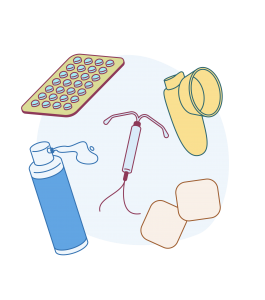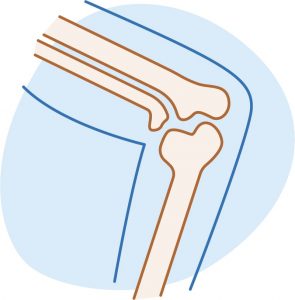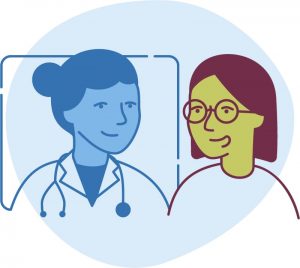
Join 1,000s of women in our pause. community
Get valuable information and support from our community and team of menopause specialists. Subscribe for the latest evidence-based information, free events, helpful articles and inspiring women’s stories.
Downloaded from www.mymenopausecentre.com
Direct URL: https://www.mymenopausecentre.com/knowledge/hormone-replacement-therapy/
Find out everything you need to know about hormone replacement therapy (HRT) – what it is, how to take it, the benefits, risks, and side effects; learn what is meant by bioidentical and body-identical hormones.

HRT stands for hormone replacement therapy. It can be the most effective way of managing menopause symptoms while transforming how you feel. It also provides long-term health benefits for many women and reduces the risk of osteoporosis, fractures, and heart disease.
If HRT is started before the age of 60, or within ten years of the menopause transition, it reduces the number of early deaths in women[1].
Many women are anxious about taking HRT – often because of how the small risks are reported. Because we believe knowledge is power, this article contains a balanced and evidence-based review of the benefits and risks. We hope that this information will help you decide whether or not HRT could be a good option for you to consider.
Read on to learn more about HRT and watch videos where we answer your burning HRT Questions.
Before the menopause, your ovaries produce three main types of hormones:
It’s the loss of oestrogens that results in most menopause symptoms. And while all women’s testosterone levels gradually decline from our 30s, this has an impact on some of us and not on others. You can find out more about testosterone here.
Put simply, HRT aims to replace the declining levels of oestrogen that your ovaries used to make and this, in turn, helps to reduce your menopause symptoms. It also has long-term health benefits, more crucial than ever as women’s life expectancy is increasing.
For most women, HRT consists of two hormones – oestrogen and a progestogen. Testosterone can also be an option.
Oestrogen is needed to manage most menopause symptoms. If you still have a womb (you have not had a hysterectomy) and take oestrogen by itself, this can thicken the lining of your womb, increasing your risk of womb cancer. The progestogen hormone is there to protect the lining of the womb.
When considering hormones, there are two types of this HRT:
If it’s less than 6-12 months since your last period, you’ll need to take sequential HRT. This means you’ll continue to have a (usually) monthly bleed. Most women take this type of HRT for around four years, or until they reach 55 (whichever comes first). By 55, most women’s periods have stopped.
Sequential HRT contains oestrogen and progestogen. You take oestrogen every single day and the progestogen is taken with this for half of the month. This causes a withdrawal bleed rather like a period. Confusingly, medical professionals don’t refer to it as a period since the bleeding is a direct result of the hormones you’re taking.
If you would prefer not to have a monthly bleed and it’s less than 6-12 months since your last period, you could opt to have a Mirena™ intrauterine system (coil) fitted and use this to protect the lining of the womb, alongside oestrogen. This contains a progestogen.
Most women experience no or minimal bleeding with a Mirena™, which lasts for five years. It also provides contraception and is a great option if you’re experiencing heavy periods.
If it’s around 12 months since your last period, you can start continuous combined HRT – with no bleed. With this version of HRT, you take oestrogen and a progestogen every day. However, if you begin this treatment too early in the menopause transition while still having periods, you may have irregular, frequent bleeding. A Mirena™ intrauterine system is also a good option here to protect the womb’s lining alongside oestrogen and to provide contraception if needed.
This HRT contains just oestrogen. You can take it if you have had a hysterectomy (you’ve had your womb removed).
There are exceptions to this rule though. Women who have had a hysterectomy for endometriosis may be advised to take a continuous combined HRT by their gynaecologist.
If you have had a subtotal hysterectomy where the womb is removed but the cervix is left behind, you may need to take combined HRT as some of the womb lining may remain. Again, you should be guided by your gynaecologist.
If you have had an endometrial ablation procedure where the womb lining is removed – usually for heavy bleeding – you would still need to take combined HRT (oestrogen and progestogen).
HRT is available in the following forms:
| Type | What you need to know | Hormones |
|---|---|---|
| Tablets | Easy to take every day. Increase the risk of blood clots, stroke and gall bladder disease. | Oestrogen and progesterone or oestrogen-only. The oestrogen is usually bioidentical.** Premarin is a type of oestrogen derived from horse urine. Tibolone is fully synthetic with oestrogen, progestogen and androgen-like action. |
| Gels | Use daily – usually to the back of the arm or inner thigh. Do not affect the risk of blood clotting or stroke at standard doses.[2] A safer option where you are at higher risk of blood clots or stroke (for example smoking, obesity, or are a migraine sufferer).* | Oestrogen only**. If you have a womb you need a progestogen also. The oestrogen is bioidentical**. |
| Patches | Stick to the skin below the waist. Usually changed twice weekly (or weekly depending on the brand). Do not affect the risk of blood clotting or stroke at standard doses. A safer option where you are at higher risk of blood clots or stroke (for example smoking, obesity, or are a migraine sufferer).* | Patches can be oestrogen-only or combined oestrogen + progestogen. If you have a womb, you need a progestogen - this can be taken through the combined patch, or separately as a progestogen tablet, or through a Mirena coil. The oestrogen in the patch is bioidentical**. The progestogen in the combined patch is synthetic, and not bioidentical. |
| Spray | Use daily. Does not affect the risk of blood clotting or stroke at standard doses. A safer option where you are at higher risk of blood clots or stroke (for example smoking, obesity, or are a migraine sufferer).* | Oestrogen-only. If you have a womb you also need a progestogen. The oestrogen is bioidentical** |
| Micronised progesterone (Utrogestan™) | Capsule – swallowed at night. Can help sleep. Likely to have a lower risk of breast cancer compared with alternatives. Unlike synthetic progestogens, it should not affect your risk of heart disease or blood clotting. | Progestogen only. Used with oestrogen. Prevents the lining of the womb from thickening. The progesterone is bioidentical**. |
| Mirena™ Intrauterine system | A ‘coil’ inserted through the neck of the womb into the cavity of the womb. Inserted by GPs, family planning clinics, gynaecologists and some menopause clinics. Lasts for five years for HRT. Also acts as a contraception. | Progestogen only. Used with oestrogen. Very effective at preventing the lining of the womb from thickening. |
| Vaginal preparations | Creams and pessaries inserted directly into the vagina to help symptoms of oestrogen loss – for example, dryness and irritation. You | Oestrogen-only. No need for progestogen if used as advised by your doctor. May also help some bladder symptoms. |
| Tibolone | Tablet. Helps menopause symptoms. Small risk of breast cancer. Risk of stroke over 60. Protection of bone – like HRT. | Fully synthetic oestrogen, progestogenic and androgenic effects. Similar to continuous combined HRT – so it’s best started after your periods have stopped. |
*You’re at higher risk of blood clots if you smoke, have a higher body weight in relation to your height (body mass index), or suffer from certain medical conditions that put you at greater risk of blood clots or stroke. Migraine sufferers can take HRT, even though they can’t take the combined oral contraceptive pill. It’s safer to use oestrogen through the skin as a patch, gel, or spray than as tablets which may further increase the risk of stroke.
**Bioidentical means that the hormone is the same as that made by your body. Bioidentical progesterone has been shown to have a lower risk of breast cancer than synthetic alternatives. It may be better tolerated, it doesn’t affect blood clotting or cholesterol, and other blood fats. We go into more detail on bioidentical hormones below.
All the different types of oestrogen can be used for the sequential or continuous combined forms of HRT.
The difference is the progestogen. If you are taking sequential HRT, you take the progestogen for half of the month and the oestrogen for the whole month. This induces a monthly bleed.
If you’re taking continuous combined HRT, you take the progestogen and oestrogen for the whole month.
The table below shows the combination of options for combined HRT – oestrogen and progestogen.
| Oestrogen | Progestogen |
|---|---|
| Gel | Utrogestan™ – micronised progesterone oral capsules Mirena™ intrauterine system (coil) Synthetic progestogen tablets |
| Spray | |
| Oestrogen only patch | |
| Combined patch | |
| Combined tablet | |
Tibolone (brand name Livial™) is a synthetic form of HRT that mimics the activity of oestrogen and progestogens – and may also have some androgen (male hormone) activity.
Tibolone has been talked about as a treatment for improving libido, but the evidence for this is not strong.
You may have read about Premarin. This is derived from horse urine (the name comes from PREgnant MARes’ urINe), so it’s ‘natural’ but contains several different types of oestrogen. Available in tablet form, it is not commonly prescribed in the UK.
A progestogen is the other hormone that you will need as part of your HRT (unless you’ve had a hysterectomy – see above). Micronised progesterone is biochemically matched to your own progesterone – so it’s bioidentical – and is available on prescription as a small capsule.
Compared to synthetic progestogens (which are versions of the same hormone), micronised progesterone has several advantages:
Unlike synthetic progestogens, micronised progesterone should not affect your risk of heart disease or blood clotting.
However, micronised progesterone is not contraceptive. If you need contraception, progesterone only or non-hormonal contraception should be used alongside the micronised progesterone containing HRT.
Vaginal oestrogens (topical oestrogens) can benefit you and are prescribed by your doctor (though there is now a product, Gina, that is available to buy over the counter as long as you meet certain criteria – you can read more below). These are oestrogen pessaries, creams and gels that are inserted directly into the vagina.
A vaginal oestrogen can help the vaginal and bladder symptoms of the menopause, known as genitourinary syndrome of the menopause.
Women often ask about the safety of using oestrogen. It’s reassuring to know that when you put oestrogen directly into your vagina, your body only absorbs a tiny amount. This means you can use it without risk of breast cancer, blood clots, stroke or heart disease.[12]
Vaginal oestrogens can be used as well as, or instead of, systemic HRT. Many women need HRT to control their general menopause symptoms in addition to a vaginal oestrogen to help vaginal and/or bladder symptoms.
There are different options available for vaginal oestrogens, shown in the table below. The dosing varies for all of them and will be confirmed on your prescription. They may take at least three months to work. If you feel they aren’t working, always speak to a doctor who can then look for other causes of your symptoms.
| Vagifem TM | Tiny pessary of 10mcg oestradiol with single use applicator for each pessary. |
| Vagirux TM | Tiny pessary of 10mcg oestradiol with 1 applicator for re-use. |
| Gina TM | Tiny pessary of 10mcg oestradiol with single use applicator for each pessary – available to buy over the counter for women who meet set criteria. |
| Imvaggis TM | Small pessary of 0.03mg oestriol. No applicator – you insert it yourself into the vagina. Melts, which some women find moisturising. |
| Ovestin cream (Estriol 0.1%) TM | Cream containing oestriol 1mg/g. Comes with a washable applicator, but you could measure out the applicator dose and use your finger instead. |
| Estriol 0.01% cream | Cream containing 0.01% oestriol. Comes with a washable applicator, but you could measure out the applicator dose and use your finger instead. |
| Blissel TM | Gel containing 50mcg/g oestriol. The lowest dose of vaginal oestrogen. This comes with an applicator. |
| Estring TM | A flexible ring that delivers 7.5mcg oestradiol per 24 hours that is fitted into the vagina, releasing oestrogen for three months. You can still continue to have sex with this fitted. |
Gina
Gina is essentially the same as Vagifem and Vagirux – 10mcg oestradiol pessaries with an applicator to help insert them. There are more restrictions in place to buying Gina over the counter than there are to getting the same medication on prescription from your doctor. Gina is available to buy to help manage vaginal symptoms of dryness, soreness, itching, burning and painful intercourse if:
If you are already taking systemic HRT (for example HRT in patches, gel, spray or tablet form), the pharmacy can only sell you Gina if you have already been prescribed it by your doctor or if your doctor has confirmed that you are suitable to use an additional vaginal oestrogen.
If you are under 50, still having periods or it is less than a year since your last period, or if you are taking HRT, it is likely that you will still be able to use a vaginal oestrogen, but you would need to talk to your GP about your symptoms to obtain this on prescription.
You can find more information on Gina here.
You may have come across the terms bioidentical and body-identical hormones. They both refer to hormones that are biochemically the same as the hormones made by your ovaries (the alternatives are synthetic hormones that ‘plug’ your hormone receptors but are not biochemically identical).
Different menopause clinics use them to mean different things. On top of that, bioidentical hormones can be regulated or compounded (unregulated). Sounds confusing? Here’s a quick guide to help you understand what it all means:
Regulated bioidentical hormones (rBHRT) are usually derived from plants and are available on a standard, regulated prescription – they can be prescribed by our clinic or your GP/specialist in the NHS. They include oestradiol and micronised progesterone. Most of the HRT prescribed by doctors in the UK is rBHRT.
These are marketed as precise duplicates of the hormones from your ovaries after blood test analysis. It’s worth noting that oestrogen levels can change day to day in the perimenopause so in reality, the blood test gives a snapshot of your hormone levels at that particular time. The hormone combination prescribed by the clinic is then made up by a private pharmacy. These combinations do not follow the same regulations as conventional HRT and haven’t been through the same strict testing processes for effectiveness and safety. The blood tests and hormones are also very expensive – significantly more than the cost of a private or NHS prescription. More expensive does not necessarily mean better. Compounded bioidentical hormones are not regulated, not available on the NHS, and are not recommended by the British Menopause Society. We do not prescribe them in our clinic.
HRT is a suitable option for the vast majority of women. Many who start HRT say that their life has been changed for the better. A phrase we frequently hear is that they feel they have a ‘glow’ about them.
The benefits generally outweigh the small risks. HRT can make all the difference in that it is an effective way of managing a wide range of menopause symptoms.
HRT helped smooth out my anxiety. I still have ups and downs, but I'm far less likely to become angry than I was before.
Patient on HRT
It can help the lesser-known symptoms too, though there may be less published evidence.

HRT replaces the oestrogen in your body. This helps keep your bones healthy, reducing your risk of osteoporosis and preventing fractures.
HRT is the most important way to prevent and treat osteoporosis in women with premature ovarian insufficiency (POI) and menopausal women below 60 years of age, particularly those experiencing symptoms of the menopause.
Heart disease is important. Women worry most about dying from breast cancer, but in actual fact, more women die of heart disease[3]. This in no way diminishes the importance of breast cancer, but it does highlight how important it is to be aware of heart disease too.
There’s a lot of conflicting, and sometimes worrying advice on the internet connecting HRT with heart disease. Here’s what we know for certain:
The evidence for HRT and the prevention of dementia is not clear. There is some evidence to suggest that HRT started early in the menopause may help prevent dementia. What is certain is that starting HRT when you’re under 60 will not increase the risk of dementia.
There is evidence to suggest that the risk of bowel cancer is reduced in women who take HRT. HRT may protect against or help osteoarthritis and joint pains can improve along with glucose control in type 2 diabetes.
The media often focuses heavily on HRT risks, yet the reality of the scientific data shows that the risks are very low for most women[5].
The risks of HRT vary from woman to woman and the type they take. The following factors can affect your long-term health and may affect the risks of HRT for you:
It’s essential that HRT is tailored to suit you by an experienced healthcare professional, as menopause management is not one-size-fits-all. A healthy diet and regular exercise will help you to reduce the risks and reap the maximum benefit from HRT.
Below we look at the evidence around the following risks of taking HRT: breast cancer, other cancers, blood clots, stroke and gallbladder disease.
Breast cancer is the risk that most concerns people in connection with HRT. What we know for certain is that:
The risk of breast cancer is likely to increase the longer you take HRT, but is still low. This risk slowly reduces when you stop HRT. The longer you have been on it, the longer this ‘tailing off’ time may take.
If you take body-identical progesterone (more on those below), some studies have shown that the risk of breast cancer is lower when compared with older, synthetic progestogens[7].
For more information on how different factors affect your risk of breast cancer, have a look at the summary results from the Women’s Health Initiative Study. It clearly shows that lifestyle factors, such as drinking alcohol and being overweight in particular, have a greater impact on your risk of breast cancer than taking HRT.
Studies show that after five years, there is little or no increase in the risk of breast cancer diagnosis in women who take oestrogen-only HRT[8]. It’s likely that there is a very small increase in the risk of breast cancer year-on-year if you take oestrogen-only HRT.
There’s a very small increase in the risk of being diagnosed with breast cancer if you take combined HRT (oestrogen and progestogen) but this doesn’t mean there is an increased risk of dying from breast cancer.
To put things in perspective, the risk of being diagnosed with breast cancer is greater if you drink the equivalent of two units of alcohol a night (a reasonable sized glass of wine) than it is from taking HRT.[9]
Dr Clare Spencer, Co-Founder of My Menopause Centre
Sequential HRT is not quite as effective in protecting the womb as continuous combined HRT. This is why after four years, or when you reach 55 years of age (the age at which most women’s periods have stopped), your therapy should be switched to continuous combined HRT.
If you have a womb and take oestrogen-only HRT in a tablet, gel, spray or patch, the risk of cancer of the womb will increase. That’s why it’s important to take a progestogen alongside oestrogen or have an ‘in date’ Mirena™ coil (within five years) to protect your womb.
If you use vaginal oestrogen, you don’t need to add a progestogen as the amount you absorb into your body is tiny.
Some studies have shown a link between HRT and some types of ovarian cancer[10]. The risk is very low. There is no evidence that taking HRT will increase your risk of dying from ovarian cancer.
Oral HRT (oestrogen in tablet form) can increase the risk of blood clots in blood vessels, such as deep vein thrombosis in the legs and pulmonary embolism in the lungs.
By contrast, oestrogen taken through the skin (transdermal oestrogen) in the form of patches, gels and sprays does not carry these same risks. Some of the older synthetic types of progestogen can also increase the risk of blood clots by a small amount.
Of course, you may already be at risk of blood clots if you smoke, are overweight or have had a blood clot in the past. If this is the case, transdermal HRT should not add to your risk.
As with the risk of blood clots, HRT tablets increase the risk of stroke. Taking oestrogen through the skin, at normal doses, does not carry the same risk. The risk of stroke increases as you get older, so for younger, healthy women, the blood clot risk for HRT is low.
Your gallbladder is the small sack that sits under your liver and helps you to digest fat. HRT tablets may increase the risk of gallbladder disease by a small amount.
There are some medical conditions where HRT may be too risky. We can’t list all the medical conditions here, but they include uncontrolled high blood pressure, active liver disease, active medical conditions where the risk of blood clotting is very high, after certain (but not all) cancers, where you have abnormal vaginal bleeding that has not been investigated.
The benefits and risks of HRT are different for everybody and it is important that you talk through your situation with a menopause specialist. It’s also important to discuss your medical history in full before thinking about starting HRT.
If you go through the menopause before you reach 40 (also known as premature ovarian insufficiency – POI), it’s important to talk to your healthcare professional about HRT. Experiencing the menopause before reaching this age has significant health risks of its own, such as:
HRT can significantly decrease these risks, and it’s important to take it until you are 51 – the average age for reaching the menopause in the UK.
If you’re concerned that it will mean you have been on HRT for years, it’s worth remembering that all you are doing is replacing the oestrogen your body would produce naturally at that age.
You may experience some of the side effects of HRT listed below when you start it and they generally settle in the first three months. Side effects can vary depending on the type of HRT you take.
| Possible oestrogens side effects | Possible progestogens side effects |
|---|---|
| Rash/itching | Breast tenderness |
| Feeling sick | Bloating |
| Leg cramps | Headaches/migraine |
| Headaches/migraine | Low mood and depression |
| Fatigue | Acne/greasy skin |
| Breast tenderness or breast swelling | Tummy pains |
| Vaginal bleeding | Nausea |
| Fluid retention – eg ankle swelling | Backache |
| Dizziness | Vaginal bleeding |
| Mood changes – low mood or anxiety | Change in vaginal discharge |
| Drowsiness | |
| Dizziness | |
| Itching |
Source: Medicines.org[11]. Please note, this list is not exhaustive, so if you’ve been prescribed hormones, please read the leaflet that comes with them.
Some women bleed when they start HRT or change their dose. This should settle in three to six months and is usually light. If the bleeding is heavy, happens after sex or persists for longer than six months, please speak to your doctor as you’ll need an examination and more tests.
Thankfully, for most women, these side effects generally settle after three months.
Some women can be intolerant of progestogens. They may experience depression, anxiety, feel like their brain isn’t fully functioning, and have severe premenstrual-type symptoms when taking progestogens. This may be limited to a single type of progestogen or may apply to all of them.
If this happens to you, speak to your doctor who may be able to tailor your regime to help. Progestogens are important, and changing from the recommended licensed regime may significantly increase the short-term risk of irregular bleeding or the long-term risk of developing endometrial cancer.
Therefore, reducing the dose or number of days that the progestogen or progesterone is taken should only be under specialist guidance.
At My Menopause Centre, we prescribe conventional, evidence-based bioidentical hormones. This means that:
The oestrogen in most HRT is oestradiol, which is biochemically identical to the oestradiol made by our ovaries. This is found in patches, gels, spray form, and tablets.
You can read more about taking HRT where there is a family history of breast cancer here.
Or watch these short videos where Dr Clare answers some frequently asked HRT questions:
As you can see, there’s a wide range of options available when it comes to HRT, so understanding the types, the benefits and risks, and what’s best for you can feel like a bit of a minefield at first.
What’s most important is finding the right solutions for you and your situation. That’s where a chat with an expert can be really worthwhile.
To talk to a friendly, knowledgeable menopause expert, book a consultation with one of our doctors.
Alternatively, you can learn more about the symptoms of the menopause or take our Menopause Questionnaire to see if, and where, you are in the menopause transition.
Dr Clare Spencer
Registered menopause specialist, GP and co-founder; see Dr Clare in person at The Spire Hospital, Leeds or online
11/05/2023
We’ve created pause. as a space for women to come together and share stories about their menopause experience, ask questions, and to find support and inspiration. We'll also share the latest news and updates on the menopause from our experts.
Share your email to receive the latest news, updates and information on new products and treatments from My Menopause Centre and our pause. community. You can unsubscribe at any time.
We're committed to protecting and respecting your privacy - see our Privacy Policy and Terms and Conditions

Whether you want to discuss your symptoms, create a treatment plan that's right for you, understand some test results or have a check-up, the highly experienced doctors and nurses in our menopause clinic are here to help you.
Book nowSource: Vinogradova Yana, Coupland Carol, Hippisley-Cox Julia. Use of hormone replacement therapy and risk of venous thromboembolism: nested case-control studies using the QResearch and CPRD databases BMJ 2019; 364 :k4810.
Source: progestogens Fournier A, Berrino F, Riboli E, Avenel V, Clavel-Chapelon F. Breast cancer risk in relation to different types of hormone replacement therapy in the E3N-EPIC cohort. Int J Cancer. 2005 Apr 10;114(3):448-54.
Source: Anderson GL, Limacher M, Assaf AR, Bassford T, Beresford SA, Black H, Bonds D, Brunner R, Brzyski R, Caan B, Chlebowski R, Curb D, Gass M, Hays J, Heiss G, Hendrix S, Howard BV, Hsia J, Hubbell A, Jackson R, Johnson KC, Judd H, Kotchen JM, Kuller L, LaCroix AZ, Lane D, Langer RD, Lasser N, Lewis CE, Manson J, Margolis K, Ockene J, O’Sullivan MJ, Phillips L, Prentice RL, Ritenbaugh C, Robbins J, Rossouw JE, Sarto G, Stefanick ML, Van Horn L, Wactawski-Wende J, Wallace R, Wassertheil-Smoller S; Women’s Health Initiative Steering Committee. Effects of conjugated equine estrogen in postmenopausal women with hysterectomy: the Women’s Health Initiative randomized controlled trial. JAMA. 2004 Apr 14;291(14):1701-12. as well as https://www.nice.org.uk/NG23/
Source: Marsden J; British Menopause Society. British Menopause Society consensus statement: The risks and benefits of HRT before and after a breast cancer diagnosis. Post Reprod Health. 2019 Mar;25(1):33-37.
Source: Collaborative Group On Epidemiological Studies Of Ovarian Cancer, Beral V, Gaitskell K, et al. Menopausal hormone use and ovarian cancer risk: individual participant meta-analysis of 52 epidemiological studies. Lancet. 2015;385(9980):1835-1842.
Source: https://www.medicines.org.uk/
Source: Santen RJ, Mirkin S, Bernick B, Constantine GD. Systemic estradiol levels with low-dose vaginal estrogens. Menopause. 2020;27(3):361-370.